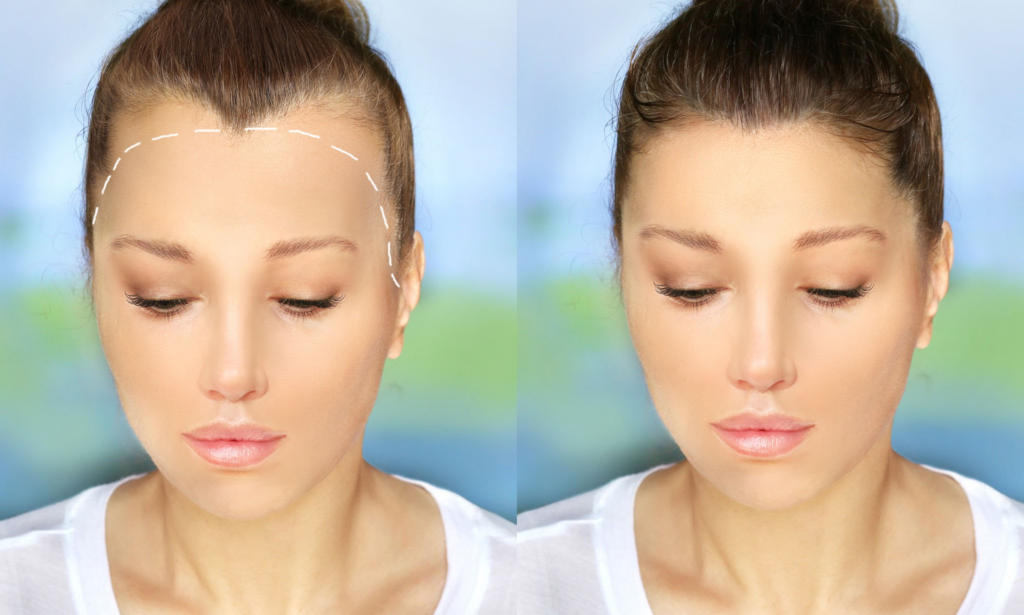Have you ever felt self-conscious about the size of your forehead? Maybe you’ve wished for a higher hairline or a more balanced facial structure. If so, you’re not alone! Many individuals struggle with insecurities about their forehead size and how it impacts their overall appearance. This is where forehead reduction surgery, also known as hairline lowering surgery, comes in.
Forehead reduction surgery can help achieve a more balanced facial profile by reducing the height of your forehead and creating a more aesthetically pleasing hairline. But, before you dive headfirst into this procedure, let’s delve deeper into the world of forehead reduction surgery. We’ll explore its intricacies, potential benefits, and everything you need to know before making a decision.
Procedure Details
So, how does forehead reduction surgery work? Imagine a sculptor carefully shaping clay – that’s how a skilled surgeon approaches forehead reduction. The procedure involves strategically removing excess skin and tissue from the forehead, then repositioning the remaining skin to create a lower hairline.
There are two primary techniques: one-stage and two-stage surgery. In one-stage surgery, the surgeon performs the entire procedure in a single session. It’s a bit like a one-stop shop for a new hairline. In two-stage surgery, the procedure is divided into two separate operations – the first stage focuses on removing excess skin and the second stage, typically performed a few months later, involves repositioning the hairline and fine-tuning the results.
But it’s not all about the tools; it’s about the expertise. You’ll be working with a skilled surgeon who can skillfully maneuver scalp flaps and carefully adjust the hairline to create a natural-looking outcome.
Cost and Factors
Now, let’s talk about the money side of things. Forehead reduction surgery isn’t a cheap date, but it’s an investment in your appearance and self-confidence. The cost can vary depending on several factors, and it’s crucial to consider them before you start shopping for surgeons.
Think of it like buying a custom-made suit: location, tailor’s experience, and fabric choices all impact the price. The same applies to forehead reduction.
Here’s a breakdown of the factors that influence the cost:
- Location: Surgery in major cities with higher living costs generally translates to higher fees.
- Surgeon’s Experience: A highly experienced surgeon will likely have higher fees. Just like you’d pay more for a renowned artist, the same concept applies to skilled surgeons.
- Anesthesia: General anesthesia is typically more expensive than local anesthesia.
- Additional Procedures: If you combine forehead reduction with other procedures, like a brow lift or face lift, the overall cost will naturally increase.
Candidate Eligibility
Not everyone is a suitable candidate for forehead reduction surgery. It’s like trying to fit a square peg in a round hole; some factors determine if you’re the right fit for this procedure.
Here’s what surgeons typically look for:
- Scalp Laxity: The stretchiness of your scalp plays a crucial role. It’s like a rubber band – if it’s too tight, it might not stretch enough for the surgery.
- Hair Thickness and Density: If your hair is too thin or sparse, it might not cover the surgical incision well, potentially affecting the final aesthetic.
- Family History of Hair Loss: If you have a family history of hair loss, it’s important to discuss it with your surgeon, as it might impact the longevity of your results.
If you don’t meet these criteria, don’t despair! There are alternative options available, such as hair transplantation or non-surgical treatments.

Benefits and Outcomes
Let’s talk about the positive side: What are the benefits of forehead reduction surgery? It’s like unlocking a new level of confidence and feeling good in your own skin.
Here are some potential benefits:
- Reduced Forehead Height: The most obvious benefit is a more balanced forehead size. Imagine a puzzle – a smaller forehead piece creates a more harmonious overall picture.
- Improved Facial Proportions: A smaller forehead can create a more balanced and aesthetically pleasing facial structure, enhancing your features.
- Enhanced Hairline Appearance: This is one of the biggest draws for many people. A lower hairline can create a more youthful and attractive look, framing your face beautifully.
- Tightened Skin and Reduced Forehead Wrinkles: Forehead reduction surgery can help tighten the skin on your forehead, reducing the appearance of wrinkles and creating a smoother, more youthful look.
The timeline for noticing results can vary, but many people start seeing improvements within a few months. The longevity of the results depends on factors like your age, skin elasticity, and lifestyle.
Risks and Complications
Like any surgical procedure, forehead reduction surgery comes with potential risks and complications.
Here’s a rundown of the things to be aware of:
- Scarring: Scars are a common part of any surgical procedure, and while surgeons work diligently to minimize their appearance, scarring is a possibility.
- Bleeding: Bleeding during or after surgery is a possible risk, but it’s usually manageable with proper care and techniques.
- Hair Loss: While unlikely, hair loss around the surgical site is a potential risk, but it’s typically temporary.
- Numbness: Numbness or altered sensation in the forehead is another potential complication, but it usually resolves over time.
It’s crucial to discuss these risks in detail with your surgeon and ask about the likelihood of these complications happening.
Recovery Process
Imagine a marathon – it’s not a sprint, and recovering from forehead reduction surgery takes time.
Here’s what you can expect:
- Post-operative Care Instructions: Your surgeon will provide detailed instructions for caring for your incision and managing pain and swelling.
- Pain Management: Pain medication will be prescribed to help you manage any discomfort. It’s like a safety net for your recovery.
- Swelling and Bruising: Swelling and bruising are common after forehead reduction surgery and usually subside within a few weeks. It’s like a temporary makeover for your forehead.
- Sutures Removal: Sutures are typically removed within a week or two after the procedure.
- Return to Normal Activities: You can expect to return to lighter activities within a week or two, but more strenuous activities will need to be avoided for several weeks.
Following your surgeon’s post-operative instructions is crucial for a smooth recovery.
Choosing a Surgeon
Finding the right surgeon for forehead reduction surgery is crucial. It’s like finding the perfect partner for your forehead journey.
Here’s how to find a qualified and experienced surgeon:
- Board Certification: Look for a surgeon who is board-certified in facial plastic surgery or hair restoration. They have the expertise and training to handle complex facial procedures.
- Research: Do your homework. Research potential surgeons online, read patient testimonials, and review before-and-after photos.
- Consultations: Schedule consultations with several surgeons to discuss your goals and expectations. This allows you to ask questions and feel comfortable with the surgeon’s approach.
Choosing the right surgeon can significantly impact your results and overall experience.
Alternative Options
Forehead reduction surgery isn’t the only solution for forehead concerns.
Here are some alternative procedures and treatments:
- Hair Transplantation: This involves transplanting hair follicles from the back of your head to the hairline, creating a fuller and lower hairline.
- Brow Lift: A brow lift can help elevate your eyebrows and create a more youthful and balanced appearance.
- Non-surgical Treatments: Botox and fillers can temporarily smooth out forehead wrinkles and create a smoother, more youthful look.
These alternative options offer different benefits and limitations, so it’s vital to discuss them with a qualified surgeon to determine the best approach for your individual needs.

Conclusion
Forehead reduction surgery can be a transformative experience, helping individuals achieve a more balanced facial profile, a more pleasing hairline, and increased self-confidence. It’s crucial to approach this procedure with careful consideration, understanding the benefits, risks, costs, and recovery process.
Always remember to consult with a qualified and experienced surgeon to discuss your individual needs, explore your options, and make an informed decision. Forehead reduction surgery can be a rewarding journey, but it’s important to take the right steps to ensure a positive outcome.
Hairtrans.com was founded by world-famous plastic surgeon Dr. MFO, who is an expert in facial feminization or facial masculinization surgeries, and is managed under his leadership. Would you like to have a hair transplant under the coordination of a plastic surgeon with many years of experience?
Whether you are a trans woman or a natural born male or female, if you are looking for the best hair transplant, contact us now.
FAQs
You have questions, we have answers! Here’s a roundup of some commonly asked questions about forehead reduction surgery:
1. How long does forehead reduction surgery take?
The duration of forehead reduction surgery varies depending on the complexity of the procedure and the techniques used. It typically ranges from a few hours to several hours.
2. What kind of anesthesia is used for forehead reduction surgery?
Forehead reduction surgery is usually performed under general anesthesia, which means you’ll be asleep during the procedure. However, in some cases, local anesthesia with sedation might be used.
3. When can I return to work after forehead reduction surgery?
The recovery timeline varies depending on the individual and the extent of the surgery. You can expect to return to lighter activities within a week or two, but more demanding work might require several weeks of recovery.
4. Will I have visible scars after forehead reduction surgery?
While surgeons strive to minimize scarring, some scarring is inevitable. The incisions are usually placed strategically in the hairline, where they’re less noticeable. The scars typically fade over time, blending in with your natural hairline.
5. How long do the results of forehead reduction surgery last?
The longevity of the results depends on several factors, including your age, skin elasticity, and lifestyle. The results are generally long-lasting, but natural aging can impact the final outcome over time.
6. What are the alternative treatments to forehead reduction surgery?
There are several alternative treatments for addressing forehead size and hairline concerns, such as:
- Hair transplantation: This involves transplanting hair follicles from the back of your head to the hairline.
- Brow lift: This procedure lifts and repositions the brow, creating a more youthful and balanced appearance.
- Non-surgical treatments: Botox and fillers can temporarily smooth out forehead wrinkles and create a more youthful look.
7. Can I combine forehead reduction surgery with other procedures?
Yes, you can combine forehead reduction surgery with other facial procedures, such as a brow lift, face lift, or eyelid surgery. Combining procedures can often enhance the overall results and achieve a more harmonious look.
8. How do I find a qualified surgeon for forehead reduction surgery?
Finding the right surgeon is crucial for a successful outcome. Look for a surgeon who is board-certified in facial plastic surgery or hair restoration, has a proven track record, and is comfortable answering your questions and addressing your concerns.
9. Are there any insurance plans that cover forehead reduction surgery?
Insurance coverage for forehead reduction surgery is typically limited because it’s considered a cosmetic procedure. However, some insurance plans may cover the procedure if it’s medically necessary to address a medical condition or improve a functional issue.
10. How can I learn more about forehead reduction surgery?
You can find valuable information online, but it’s always best to consult with a qualified surgeon for personalized guidance and advice.


